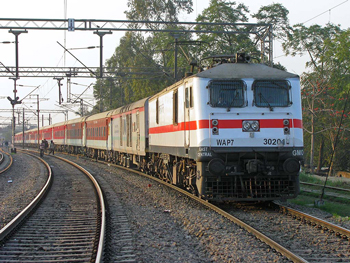|
On 19 January 2016, Indian Railways achieved another
significant milestone in their rail electrification program by commissioning
the electrification of the 87-mi-long rail line between Ghaziabad and Moradabad.
The route serves as an important link between the Howrah–Delhi main line and
the Ambala–Lucknow–Mughalsarai B route.

The
Delhi–Ghaziabad–Moradabad–Lucknow–Sultanpur– Varanasi–Mughalsarai route is an alternative
rail link bypassing the supersaturated Delhi–Kanpur–Allahabad–Mughalsarai
route. Electrification of this route will result in faster movement of
passenger-carrying trains and higher traffic throughput on the
Varanasi–Lucknow–Moradabad–Delhi route. The introduction of main-line electric
multiple unit (EMU) trains on the Ghaziabad–Moradabad section will also provide
a faster rail link between Delhi and Ghaziabad, improving service to the
western portion of the state of Uttar Pradesh. Both passenger and freight
trains on this line will be hauled by electric traction all the way from
Varanasi through Lucknow and Moradabad to Delhi.
The electrified line between Moradabad and Lucknow opened
for revenue service on 20 March 2013, and the line between Lucknow and Mughalsarai
opened later. With the electrification complete on the Ghaziabad–Moradabad
section, the entire line between Varanasi and Lucknow via Moradabad will be
connected to Delhi by electric traction. Faster movement of freight trains
using electric traction provides the agricultural products, sugar, and craft industries
of Uttar Pradesh with a better rail link to the rest of the country and boosts
the economy of the state.
The electrification project was funded at an estimated cost
of Rs. 155 crore (approximately US$24.3 million). According to their website, Indian
Railways had a total of about 15,500 route miles of electrified rail lines at
the end of 2014.
Full article: IEEE Vehicular Technology Magazine, Volume 11, Number 2 (June 2016) |